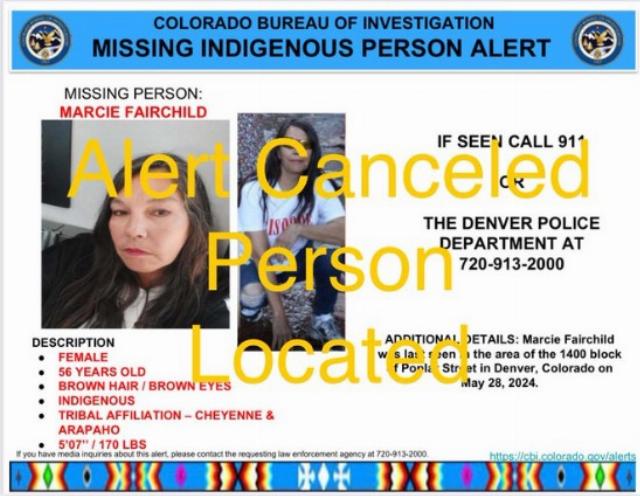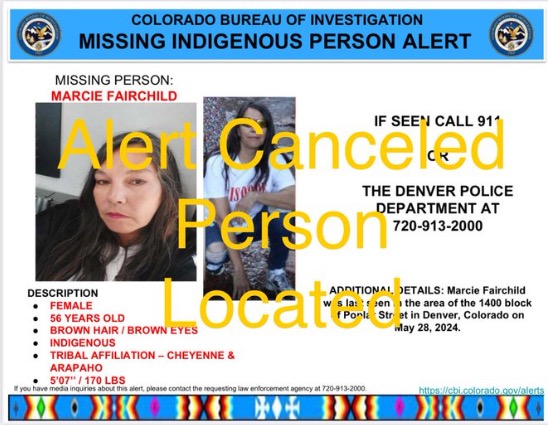

Public domain
Blue states are modeling themselves on Canada's “first people” missing person alerts, but the situation in America is very different, so the benefits are dubious.Sadly, a few days ago, the news in Denver reported that authorities had identified the remains of Marcie Fairchild, who had been missing for months. Fairchild was found not far from where she lived, and the medical examiner has not yet established a cause of death. Oddly, at least for me, was the fact that early in the search, authorities had issued something called a Missing Indigenous Person Alert (MIPA) because Fairchild had been affiliated with the Cheyenne-Arapaho tribe. I had never heard of such an alert, so I looked into it.
Colorado is the third state to embrace this alert. Following the lead of Washington state and trying to out-California California, in 2022, our ultra-blue Colorado legislature and governor introduced the MIPA to take its place alongside the well-known Amber Alert, and a raft of other alerts specific to at-risk seniors, hit-and-run drivers, dangerous attackers of peace officers, and a miscellaneous alert that may be issued for all other endangered persons.
The MIPA alert is part of this roster of identity-specific alerts. The Colorado Bureau of Investigation (“CBI”) issues it when someone with a known tribal affiliation disappears. If that person is a minor, a senior, etc., the CPI issues other identity-specific alerts, too.
For a bit of historical context, alerts for missing Indigenous persons appear to have originated in Canada, where First Nations, Inuit, and Métis peoples comprise approx. 5% of the population. Many of these folks live insularly within their own communities and have little contact with the greater Canadian population. It was the difficulty in finding a missing person from this population that prompted the Royal Canadian Mounted Police (“RCMP”) to introduce MIPAs.
<img alt captext="Public domain” height=”426″ src=”https://conservativenewsbriefing.com/wp-content/uploads/2025/02/a-missing-persons-alert-so-identity-specific-it-stops-being-useful.jpg” width=”550″>
Image: Public domain
Here in the United States, a bit over 1% of the population is Indigenous, but the great majority of these folks live with the rest of us among the general population in cities, suburbs, and rural areas (including, regrettably, Liz Warren). This situation, therefore, is different from that in Canada.
In the United States, over 600,000 people go missing each year, or approximately 6.5 per 100,000 people. The peak year was 1997 when nearly one million Americans were reported missing. Advances in databases, communications, and jurisdictional cooperation have contributed to the decline in numbers. Nonetheless, there are currently more than 20,000 unresolved missing persons and nearly 14,000 unidentified bodies in the United States.
The overwhelming majority of missing persons cases are resolved very quickly (mostly within 24 hrs.), with only 1% overall remaining open. While families of missing persons (of all ethnicities) might lament an unenthusiastic or slow police response, it is simply not illegal for an adult to “be missing.”
As American adults, we can go where we want and ignore whom we want. Absent suspicion of foul play, dementia, developmental disability, or other imperiling factors, police will follow up on leads provided by family, friends, and co-workers until leads run out. Of course, red flags such as suicidal or violent statements would result in a much more active response.
Long-term “missing persons” might, at some point, encounter law enforcement in a traffic stop. After checking these people for warrants, etc., the cop would tell them, “Hey, so-and-so reported you missing.” The response is often, “Yeah, I don’t talk to him/her/they/them anymore.” The follow-up with the reporting parties is to inform them that the people they reported as missing are safe without reporting their whereabouts. Often, adults might not even know that they were reported missing.
The motivations beyond the legislation deploying MIPAs are that indigenous persons have been marginalized and that jurisdictional issues arise when dealing with tribal officials, the Bureau of Indian Affairs, etc. There is truth in this, without question. Advocates claim violence against Indigenous people is underreported. This also may well be true.
Donna Chrisjohn (a member of the Sicangu Lakota Nation) is an Indigenous activist who worked to implement the MIPA system in Colorado. She relates how she was twice given the wrong ethnic identity when cops gave her speeding tickets, once being called Hispanic and once being called white. She questions how she would be described in a BOLO.
For my part, I wonder what’s wrong with simply describing her as an individual. As a red-blooded American male, I can only describe her file photographs as, yes, a handsome woman. And, at least to me, she does look Hispanic. If a younger photograph of her were to accompany a BOLO (as is often the case, for recent photos are not always available), she could easily be described as an attractive Hispanic woman. For me, at least, a BOLO describing her as Indigenous would cloud the search. After all, the whole point of a missing person report is to find that person, not to validate that person’s self-identity.
What is not clear to me is the effectiveness of a MIPA in facilitating the rescue or recovery of an Indigenous person. I contacted the Cheyenne-Arapaho tribal administrator and security office to find out what had happened to Ms. Fairchild, and the people there were not aware of her case. At their suggestion, I contacted the Office of Indian Affairs in Oklahoma, but there has been no follow-up. As of this writing, the Denver Police Department PIO has not returned my calls asking about the Fairchild case.
Indeed, in the last few MIPA-related cases in Colorado (Fairchild, Wanbli Vigil, Raeanna Burch-Woodhull), the alert was issued but played no role at all. Wanbli Vigil’s remains were recently found in Denver, and his death does not appear to be suspicious, while Burch-Woodhull’s husband was sentenced to 35 years for second-degree murder. Tragic? Certainly. But the circumstances are probably not related to ethnicity.
Getting back to the numbers, of the 20,000 currently missing persons in the United States, approximately 780 might be indigenous. No doubt some of those 20,000 are at risk, and some are probably deceased. It would be wonderful if, in an ideal world, law enforcement could devote intensive resources to finding them all. But experience shows many are likely fine and, for whatever reason, they are unaccounted for.
Issuance of an ethnicity-specific alert for a missing Indigenous person, absent any of the other escalating factors discussed earlier (a child, known dementia, developmental disability, violent/suicidal, etc.), when such an alert is not issued for people of other ethnicities, is flat-out discriminatory. It clearly puts white, black, Asian, etc., people at a disadvantage when their loved ones think they have gone missing. Indigenous people alerts are flashed up on highway signs, while the rest of us might get a passing mention during roll call at the local precinct.
Moreover, treating Indigenous people in this special way infantilizes them. Doing so implies that they are less capable or inferior in some way or that they are not entitled to the free association right of all Americans. I am reminded of the dialog in the Mel Brooks movie Blazing Saddles. Hedley Lamar states: “…under the provisions of this bill, we would snatch two hundred thousand acres of Indian land, which we have deemed unsuitable for their use at this time. They’re such children.”
And there is one more thing I need to mention. The California version of the MIPA is called…wait for it…a Feather Alert! I’m serious!
Maybe I am overly woke-sensitized after 4 years of harebrained Democrat party rule, but does that not seem a tad insensitive? I’m offended! Would an alert for me (a New York City-born, Italian-American Yankee fan) be called a lasagna alert? Al dente, please. For a Hispanic: a taco alert? For a Jew: a yarmulke alert? Gimme a break, Gavin!
To top it off, our most well-known missing person of the last four years, Joe Biden, declared May 5 to be Missing or Murdered Indigenous Person Awareness Day. I guess he forgot about Cinco de Mayo.
[At this writing, the Colorado community is reeling from the death of 18-year-old Megan Trussell, a student at the University of Colorado, whose body was found in a mountain canyon on February 15, 2025. She was the subject of a MIPA alert. It is not clear if the alert aided in the discovery. It does appear that what did help to find her body was the last ping of her phone.]
Dr. Bruno, a scientist retired after more than 40 years in research, amuses himself writing books and editing scientific journals, along with wood and metal working.





